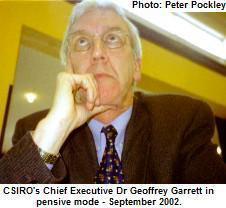
|
News & Views item - December 2004 |
![]() The
Spins the Thing Whereby He'll Catch the Makings of the Ring? (December
21, 2004)
The
Spins the Thing Whereby He'll Catch the Makings of the Ring? (December
21, 2004)
The doyen of Australian science writers, Peter Pockley, has had CSIRO in his sights for a couple of years now, or more particularly CEO, Geoffrey Garrett and his managerial appointees. In his final edition of "Pockley's Razor" for Australasian Science (Jan/Feb 2005) he takes the senior spin merchant to task, "You know an organisation is in trouble when its 'leaders' engage in self-description. The rhetorical rot is evident throughout Garrett's 'strategic plans' that are replete with 'great science, cutting edge, world-class science and global reputation'. None of these proclamations has come from independent observers. Lately, Deputy Chief Executive Dr Ron Sandland added 'exciting' to the lexicon approved for 'corporate communications', and Garrett is using 'brilliant science' as his superlative." A senior CSIRO scientist told Dr Pockley, "Chiefs are being sent to business schools instead of major research institutions for intellectual refreshment." The comment wasn't said in praise of Caesar.
And there seems also to be an element of the tail wagging the dog when it comes determining the salary structure within the organisation. The CSIRO Communications Director, Donna Staunton, receives somewhere between $260,000–$330,000. Divisional Chief's, supposedly chosen for the administrative ability as well as scientific excellence, are on $144,584 to $162,888 per annum.
Years ago a very senior CSIRO executive told the Silver Blonde who reports for TFW from time to time that "if you're gonna stuff up make sure you've made a first class mess, that way you'll probably get a kick upstairs."
In any case Peter Pockley has good company in his assessment of the current
state of the Commonwealth Scientific and Industrial Research Organisation.
Stanford's Professor of Biological Sciences
Paul Ehrlich in a recent conversation![]() with Robyn Williams bemoaned the demise of CSIRO's standing in
world science.
with Robyn Williams bemoaned the demise of CSIRO's standing in
world science.